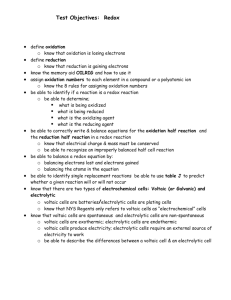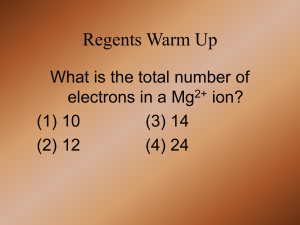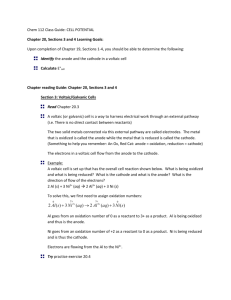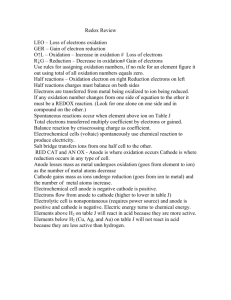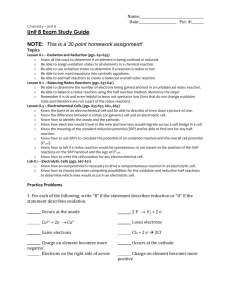Regents Chemistry
advertisement
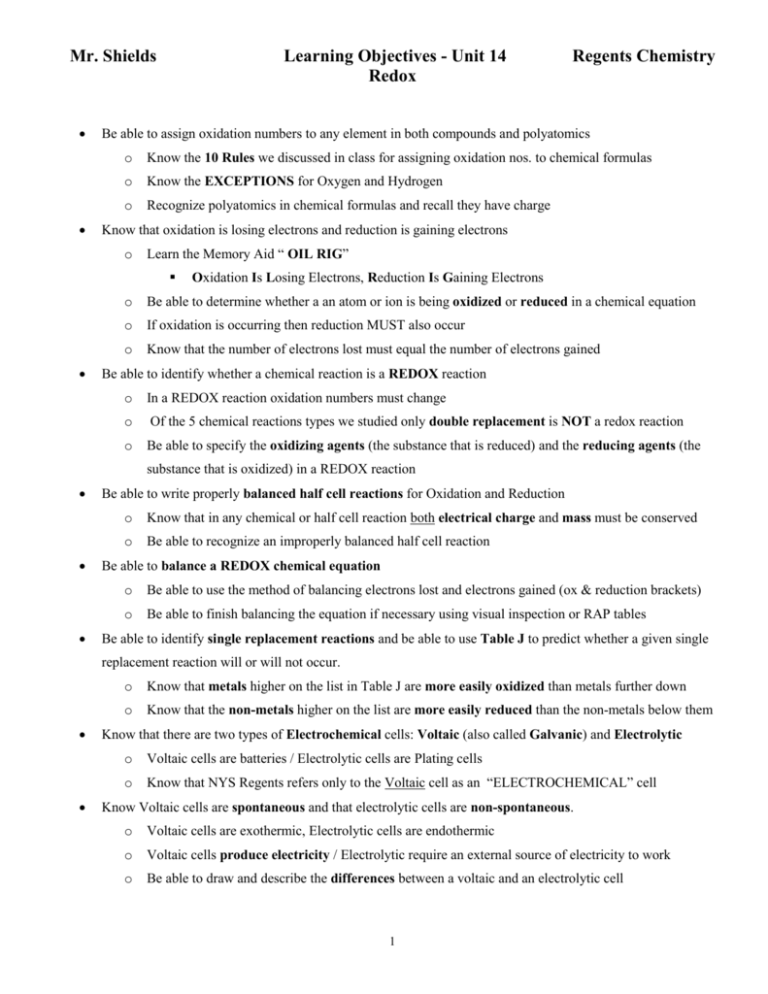
Mr. Shields Learning Objectives - Unit 14 Redox Be able to assign oxidation numbers to any element in both compounds and polyatomics o Know the 10 Rules we discussed in class for assigning oxidation nos. to chemical formulas o Know the EXCEPTIONS for Oxygen and Hydrogen o Recognize polyatomics in chemical formulas and recall they have charge Know that oxidation is losing electrons and reduction is gaining electrons o Learn the Memory Aid “ OIL RIG” Regents Chemistry Oxidation Is Losing Electrons, Reduction Is Gaining Electrons o Be able to determine whether a an atom or ion is being oxidized or reduced in a chemical equation o If oxidation is occurring then reduction MUST also occur o Know that the number of electrons lost must equal the number of electrons gained Be able to identify whether a chemical reaction is a REDOX reaction o In a REDOX reaction oxidation numbers must change o Of the 5 chemical reactions types we studied only double replacement is NOT a redox reaction o Be able to specify the oxidizing agents (the substance that is reduced) and the reducing agents (the substance that is oxidized) in a REDOX reaction Be able to write properly balanced half cell reactions for Oxidation and Reduction o Know that in any chemical or half cell reaction both electrical charge and mass must be conserved o Be able to recognize an improperly balanced half cell reaction Be able to balance a REDOX chemical equation o Be able to use the method of balancing electrons lost and electrons gained (ox & reduction brackets) o Be able to finish balancing the equation if necessary using visual inspection or RAP tables Be able to identify single replacement reactions and be able to use Table J to predict whether a given single replacement reaction will or will not occur. o Know that metals higher on the list in Table J are more easily oxidized than metals further down o Know that the non-metals higher on the list are more easily reduced than the non-metals below them Know that there are two types of Electrochemical cells: Voltaic (also called Galvanic) and Electrolytic o Voltaic cells are batteries / Electrolytic cells are Plating cells o Know that NYS Regents refers only to the Voltaic cell as an “ELECTROCHEMICAL” cell Know Voltaic cells are spontaneous and that electrolytic cells are non-spontaneous. o Voltaic cells are exothermic, Electrolytic cells are endothermic o Voltaic cells produce electricity / Electrolytic require an external source of electricity to work o Be able to draw and describe the differences between a voltaic and an electrolytic cell 1 Mr. Shields Learning Objectives - Unit 14 Redox Regents Chemistry Be able to draw and label all the components for a given Voltaic cell including: Both half cells & solution , salt bridge and solution, wire, direction of electron flow, cathode, anode, where oxidation occurs, where reduction occurs, what electrode increases in mass and which decreases in mass, which electrode is positive and which is negative. Know that In that in a Voltaic cell the Cathode (+) gains mass as the reaction proceeds o Anode (-) loses mass o Cathode Solution concentration decreases o Anode Solution concentration increases Know the use of the following “memory jogger” for voltaic cells: AN Ox ate a Red Pussy Cat o Be able to explain the purpose of a Salt Bridge o Know that without a salt bridge an electrochemical reaction could not occur o Be able to explain which way the ions in a salt bridge flow and why Be able to write the oxidation and reduction half cell reactions occurring in a Voltaic cell o Given two metals and using Table J, be able to construct a properly labeled Voltaic cell Be able to describe two uses of an electrolytic cell (production of metals (Downs cell), electroplating) o These letter refer to: Anode, Negative, Oxidation / Reduction, Positive, Cathode Be able to describe a Downs (fused salt) cell for the production of pure elements Be able to draw and label all the components of a fused salt cell and an electroplating cell: the anode, cathode, what’s positive, what’s negative, electron flow, chemical components, and be able to write the oxidation and reduction half cell reactions that are occurring. Define the term electrolysis o Be able to describe a simple cell for the electrolysis of water Know that in an electroplating cell what gets plated is the cathode (i.e. where reduction occurs) Know that the “polarity” of the anode and cathode in an electrolytic cell is opposite that of a Voltaic cell o Cathode is still where reduction occurs and Anode is still where oxidation occurs Know the use of the following “memory jogger” for electrolytic cells: “A POX ON ELECTROLYTIC CELLS”. o These letters refer to: Anode, Positive, Oxidation o Cathodes are Negative and Reduction occurs at the cathode in electrolytic cells 2




